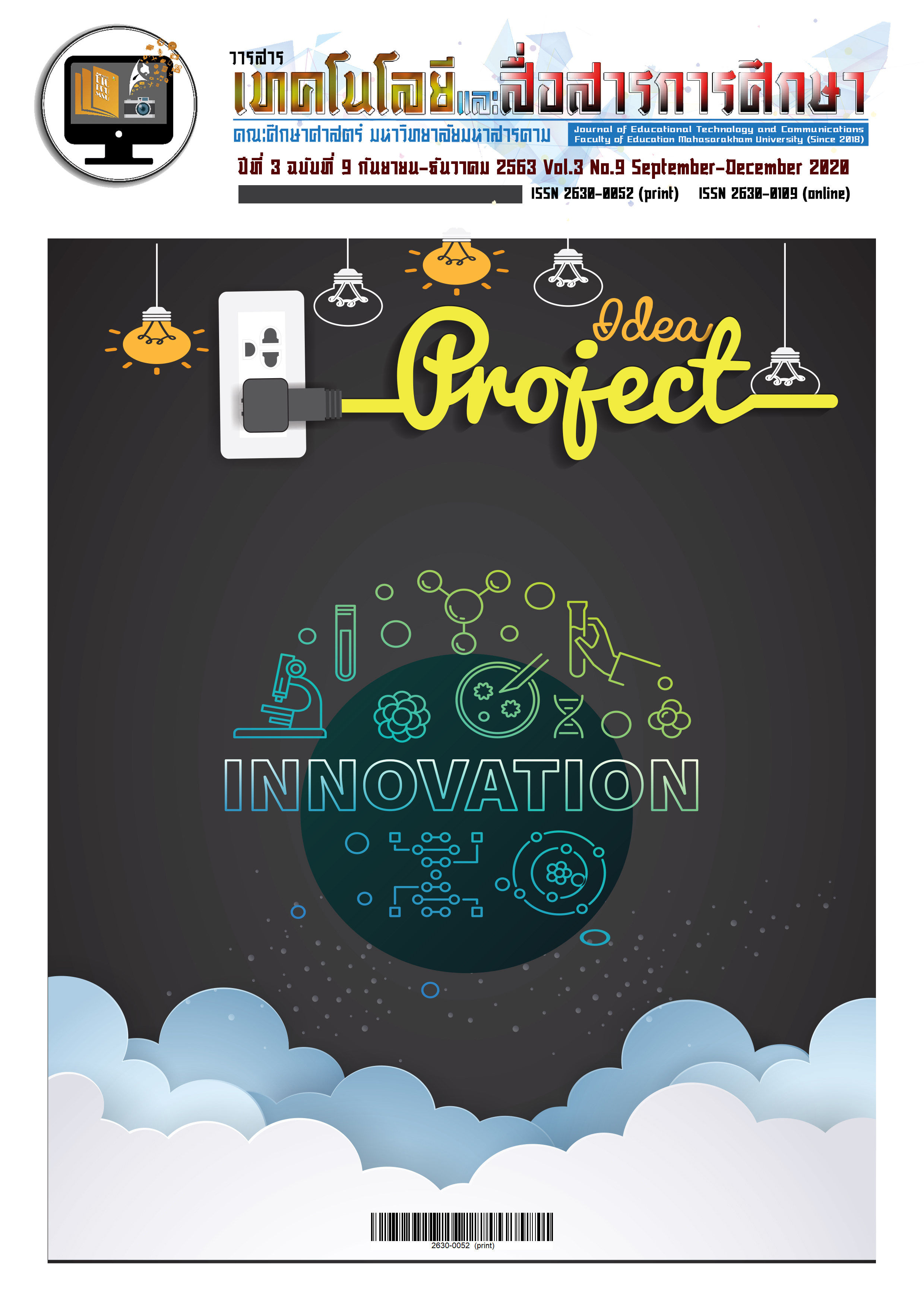การเปรียบเทียบความสามารถในการคิดวิเคราะห์และผลสัมฤทธิ์ทางการเรียนระหว่างใช้กิจกรรมการเรียนรู้ปัญหาเป็นฐานร่วมกับผังกราฟิกกับการจัดกิจกรรมการเรียนรู้แบบปกติ รายวิชาสังคมศึกษาศาสนาและวัฒนธรรม นักเรียนชั้นมัธยมศึกษาปีที่ 2
Main Article Content
บทคัดย่อ
การวิจัยครั้งนี้จึงมีจุดมุ่งหมาย 1) เพื่อเปรียบเทียบความสามารถในการคิดวิเคราะห์ และผลสัมฤทธิ์ทางการเรียน ที่ได้รับการจัดกิจกรรมการเรียนรู้ปัญหาเป็นฐานร่วมกับผังกราฟิก วิชาสังคมศึกษาศาสนาและวัฒนธรรม ชั้นมัธยมศึกษาปีที่ 2 ระหว่างก่อนเรียนและหลังเรียน 2) เพื่อเปรียบเทียบความสามารถในการคิดวิเคราะห์ และผลสัมฤทธิ์ทางการเรียน วิชาสังคมศึกษาศาสนาและวัฒนธรรม ชั้นมัธยมศึกษาปีที่ 2 ระหว่างการจัดกิจกรรมการเรียนรู้ปัญหาเป็นฐานร่วมกับผังกราฟิกกับการจัดกิจกรรมการเรียนรู้แบบปกติ 3) เพื่อศึกษาเจตคติต่อการเรียนวิชาสังคมศึกษาศาสนาและวัฒนธรรม กลุ่มตัวอย่างที่ใช้ในงานวิจัยครั้งนี้ ได้แก่ นักเรียนชั้นมัธยมศึกษาปีที่ 2 กำลังเรียนในภาคเรียนที่ 2 ปีการศึกษา 2562 โรงเรียนสุวรรณภูมิพิทยไพศาล อำเภอสุวรรณภูมิ จังหวัดร้อยเอ็ด ซึ่งกลุ่มตัวอย่างได้มาโดยการสุ่มแบบกลุ่ม (Cluster random sampling) โดยใช้ห้องเรียนเป็นหน่วยในการสุ่ม เพื่อแบ่งกลุ่มทดลองเป็น 2 กลุ่ม กลุ่มละ 36 คน คือ กลุ่มที่เรียนโดยการจัดกิจกรรมการเรียนรู้แบบปัญหาเป็นฐานร่วมกับผังกราฟิก ได้นักเรียนชั้นมัธยมศึกษาปีที่ 2/6 และกลุ่มที่เรียนโดยการจัดกิจกรรมการเรียนรู้แบบปกติ ได้นักเรียนชั้นมัธยมศึกษาปีที่ 2/5 ใช้เวลาเรียนรู้กลุ่มละ 15 ชั่วโมง เครื่องมือที่ใช้ในการวิจัย 1) แผนการจัดการเรียนรู้โดยใช้ปัญหาเป็นฐานร่วมกับผังกราฟิกและแผนจัดการเรียนรู้แบบปกติ จำนวน 7 แผน ใช้เวลา 15 ชั่วโมง 2) แบบทดสอบวัดความสามารถในการคิดวิเคราะห์ เป็นแบบปรนัยเลือกตอบ 4 ตัวเลือก จำนวน 25 ข้อมีค่าความเชื่อมั่นทั้งฉบับ 0.89 3) แบบทดสอบวัดผลสัมฤทธิ์ทางการเรียนสังคมศึกษาศาสนาและวัฒนธรรม ของนักเรียนชั้นมัธยมศึกษาปีที่ 2 เป็นแบบปรนัยเลือกตอบ 4 ตัวเลือก จำนวน 30 ข้อมีค่าความเชื่อมั่นทั้งฉบับ 0.87 4) แบบวัดเจตคติต่อการเรียนวิชาสังคมศึกษา ของนักเรียนชั้นมัธยมศึกษาปีที่ 2 เป็นแบบมาตราส่วนประมาณค่า (Rating Scale) ชนิด 5 ระดับ จำนวน 20 ข้อ มีค่าความเชื่อมั่นทั้งฉบับ 0.87 สถิติที่ใช้ในการวิเคราะห์ข้อมูล ได้แก่ ร้อยละ ค่าเฉลี่ย ส่วนเบี่ยงเบนมาตรฐาน และทดสอบสมมุติฐาน ใช้สถิติ t-test แบบ Dependent Samples และ t-test แบบ Independent Samples
ผลการวิจัยปรากฏดังนี้
1. นักเรียนที่ได้รับการจัดการเรียนรู้ปัญหาเป็นฐานร่วมกับผังกราฟิก มีคะแนนความสามารถในการคิดวิเคราะห์ และผลสัมฤทธิ์ทางการเรียนของนักเรียน ชั้นมัธยมศึกษาปีที่ 2 หลังเรียนสูงกว่าก่อนเรียนอย่างมีนัยสำคัญทางสถิติที่ .05
2. นักเรียนที่ได้รับการจัดการเรียนรู้ปัญหาเป็นฐานร่วมกับผังกราฟิก ชั้นมัธยมศึกษาปีที่ 2 มีความสามารถในการคิดวิเคราะห์ไม่แตกต่างกันกับการกิจกรรมการเรียนรู้แบบปกติและนักเรียนที่ได้รับการจัดการเรียนรู้ปัญหาเป็นฐานร่วมกับผังกราฟิก ชั้นมัธยมศึกษาปีที่ 2 มีผลสัมฤทธิ์ทางการเรียนสูงกว่าการกิจกรรมการเรียนรู้แบบปกติอย่างมีนัยสำคัญทางสถิติที่ .05
3. นักเรียนชั้นมัธยมศึกษาปีที่ 2 มีเจตคติต่อวิชาสังคมศึกษาศาสนาและวัฒนธรรม โดยรวมอยู่ในระดับมากที่สุด
โดยสรุป การจัดกิจกรรมการเรียนรู้ปัญหาเป็นฐานร่วมกับผังกราฟิก วิชาสังคมศึกษาศาสนาและวัฒนธรรม นักเรียนชั้นมัธยมศึกษาปีที่ 2 ส่งผลให้นักเรียนมีความสามารถในการคิดวิเคราะห์ ผลสัมฤทธิ์ทางการเรียน และมีเจตคติที่ดีต่อการเรียน จึงควรส่งเสริมและสนับสนุนให้ครูนำรูปแบบการจัดกิจกรรมการเรียนรู้ปัญหาเป็นฐานร่วมกับผังกราฟิก ไปใช้ในการจัดกิจกรรมการเรียนรู้ต่อไป
Downloads
Article Details
เอกสารอ้างอิง
ณัฏฐมณฑน์ ณัฎฐปัญญามาศ. (2553). การเปรียบเทียบผลสัมฤทธิ์ทางการเรียน ความสามารถการคิดวิเคราะห์และการยอมรับนับถือ
ตนเอง ของนักเรียนชั้นมัธยมศึกษาปีที 1 ระหว่างการจัดการเรียนรู้โดยใช้โยนิโสมนสิการกับการจัดการเรียนรู้โดยใช้ผังกราฟิก. วิทยานิพนธ์ กศ.ม. (หลักสูตรและการสอน). มหาสารคาม : มหาวิทยาลัยมหาสารคาม.
ดวงกมล สินเพ็ง. (2553). การพัฒนาผู้เรียนสู่สังคมแห่งการเรียนรู้ : การจัดการเรียนการสอนที่เน้นผู้เรียนเป็นศูนย์กลางกลุ่มสาระการ
เรียนรู้สังคมศึกษา ศาสนาและวัฒนธรรม. พิมพ์ครั้งที่ 2. กรุงเทพฯ : สำนักพิมพ์แห่งจุฬาลงกรณ์มหาวิทยาลัย,
ทิศนา แขมมณี. (2555). ศาสตร์การสอน : องค์ความรู้เพื่อการจัดกระบวนการเรียนรู้ที่มีประสิทธิภาพ. กรุงเทพฯ : โอเดียนสโตร์,
ธนวัฒน์ คำเบ้าเมือง. (2553). การเปรียบเทียบผลสัมฤทธิ์ทางการเรียน ความสามารถในการคิดวิเคราะห์แรงจูงใจใฝ่สัมฤทธิ์ต่อการเรียน
วิชาคณิตศาสตร์ เรื่อง รูปสี่เหลี่ยม ชั้นประถมศึกษาปีที่ 6 ระหว่างการจัดกิจกรรมการเรียนรู้ โดยใช้ปัญหาเป็นฐาน (PBL) กับการจัดกิจกรรมการเรียนรู้แบบปกติ. วิทยานิพนธ์ กศ.ม. มหาสารคาม : มหาวิทยาลัยมหาสารคาม,
นิราศ จันทรจิตร. (2553) การเรียนรู้ด้านการคิด. มหาสารคาม : สำนักพิมพ์มหาวิทยาลัยมหาสารคาม,
บุญชม ศรีสะอาด. (2545) การวิจัยเบื้องต้น. กรุงเทพฯ : สุวีริยาสาส์น, .
______. (2553). พื้นฐานการวิจัยการศึกษา. พิมพ์ครั้งที่ 6. กาฬสินธุ์ : ประสานการพิมพ์,
ประพันธ์ศิริ สุเสารัจ. (2551). การพัฒนาการคิด. พิมพ์ครั้งที่ 2. กรุงเทพฯ : โรงพิมพ์ห้างหุ้นส่วนจำกัด 9119 เทคนิค พริ้นติ้ง,
พวงรัตน์ บุญญานุรักษ์. (2544). การเรียนรู้โดยใช้ปัญหาเป็นฐาน PROBLEM – BASED LEARNING. วิทยานิพนธ์,มหาวิทยาลัยบูรพา
วลัย พานิช. (2549). ประมวลทบความกิจกรรมพัฒนาผู้เรียนสู่มาตรฐานการเรียนรู้ กลุ่มสาระการเรียนรู้สังคมศึกษา ศาสนาและวัฒนธรรม. กรุงเทพฯ: จุฬาลงกรณ์มหาวิทยาลัย.
สถาบันส่งเสริมการสอนวิทยาศาสตร์และเทคโนโลยี. (2547). การจัดสาระการเรียนรู้กลุ่มวิทยาศาสตร์หลักสูตร การศึกษาขั้นพื้นฐาน.
กรุงเทพฯ : สถาบันส่งเสริมการสอนวิทยาศาสตร์และ เทคโนโลยี,
สมนึก ภัททิยธนี. (2553). การวัดผลการศึกษา. พิมพ์ครั้งที่ 7. กาฬสินธุ์ : ประสานการพิมพ์,
สำนักงานเขตพื้นที่การศึกษามัธยมศึกษา เขต 27. (2561). รายงานผลการทดสอบทางการศึกษาแห่งชาติขั้นพื้นฐาน (O-Net).
ร้อยเอ็ด : สำนักงานเขตพื้นที่การศึกษามัธยมศึกษา เขต 27,
สุคนธ์ สินธพานนท์. (2550). สุดยอดวิธีสอนสังคมศึกษา ศาสนาและวัฒนธรรม นาไปสู่...การจัดการเรียนรู้ของครูยุคใหม่. กรุงเทพฯ :
อักษรเจริญทัศน์,
สุมน อมรวิวัฒน์. (2533). คิดตามนัยแห่งพุทธธรรม. กรุงเทพฯ : จุฬาลงกรณ์มหาวิทยาลัย,
สุวิทย์ มูลคำ และอรทัย มูลคำ. (2544). เรียนรู้สู่ครูมืออาชีพ. พิมพ์ครั้งที่ 5. กรุงเทพฯ : ที.พี.พริ้นท์,
Bloom, Benjamin S. (1965). Taxonomy of Education Objectives. Handbook 1: Cognitive Domain.New York:
David Mckey Company. Inc,


